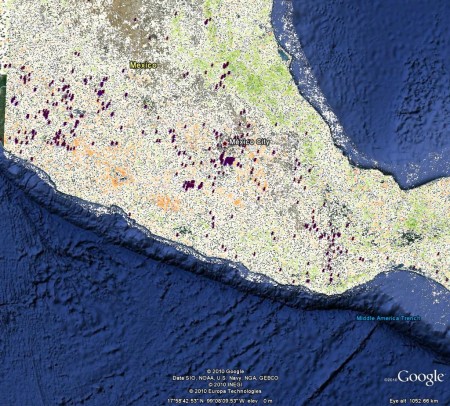The other recent Google Earth innovation is Earth Engine, where you can check out a bunch of interesting visualizations of environmental data. Spurred by something Julian said, I downloaded the MODIS VCF global tree cover change dataset (2000-2005). And then I went to Genesys and downloaded data on wild beans (Phaseolus spp). It was not very difficult to put the two together in Google Earth. In the map below, which just looks at central Mexico, orange means high deforestation, and green afforestation. Is it me, or do germplasm accession seem to be concentrated in areas of high deforestation? Anyway, with a little work, this could be a cheap and cheerful way to identify particularly threatened areas for germplasm collecting.
Who wants to be the first to put crop wild relatives data in Earth Engine?

In fact, everything is available online, but in different sites, through very nice and interactive interfaces:
1. Visualising species data
2. Visualising protected areas
3. Visualising species data and protected areas, a mashup of (1) and (2)
However, some coordination is still required to have all these data together in Google Earth Engine (GEE). On the other side, online harvesting of GBIF data for mashing up in GEE shouldn’t be that hard.
Bit of a slippery slope, this. No problem with wild Phaseolus growing in disturbed (deforested) areas – they, like crops, don’t like tree cover. But if you collect samples, they will eventually be used and if they are used for adaptation to climate change, wild genes will expand the ecological tolerance of the crop and allow agricultural expansion and encourage yet more deforestation (with yet more genetic erosion of wild relatives of lots of crops).
A good example is the natural cross of tetraploid wheat with a diploid goat-grass thousands of years ago. The result – hexaploid bread wheat – now covers 24% of arable land and has replaced natural vegetation in North and South America and Australia and lots of Europe and Asia at a high but as yet unquantified cost to wild germplasm needed for future crop breeding.
In the rush to climate-proof crops has anyone thought through the inevitably of future genetic erosion of wild relatives?